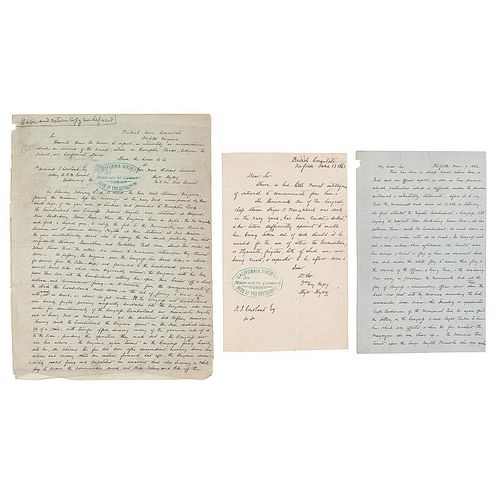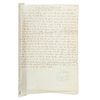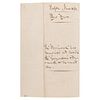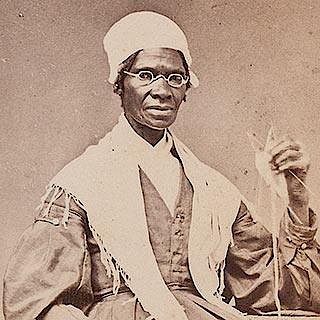Civil War Letters to the British Consul in Richmond Describing the Battle of Hampton Roads and the Monitor & Merrimack
About Seller
6270 Este Ave.
Cincinnati , OH 45232
United States
With offices in Cincinnati, Cleveland and Denver, Cowan’s holds over 40 auctions each year, with annual sales exceeding $16M. We reach buyers around the globe, and take pride in our reputation for integrity, customer service and great results. A full-service house, Cowan’s Auctions specializes in Am...Read more
Two ways to bid:
- Leave a max absentee bid and the platform will bid on your behalf up to your maximum bid during the live auction.
- Bid live during the auction and your bids will be submitted real-time to the auctioneer.
Bid Increments
| Price | Bid Increment |
|---|---|
| $0 | $25 |
| $500 | $50 |
| $1,000 | $100 |
| $2,000 | $250 |
| $5,000 | $500 |
| $10,000 | $1,000 |
| $20,000 | $2,500 |
| $50,000 | $5,000 |
| $100,000 | $10,000 |
About Auction
Jun 9, 2017 - Jun 10, 2017
Cowan's Auctions dawnie@cowans.com
- Lot Description
Lot of 3 letters written by Myer Myers of Norfolk, VA, to the British Consul in Richmond, with two pertaining to the Battle of Hampton Roads. The earliest letter, Norfolk, June 13, 1861, is a brief letter in which he notes that the Merrimack has been raised, docked, and repaired. The Germantown and Plymouth were also to be raised and repaired.
The letter dated March 9, 1862, 2pp, is a very early account of the Battle of Hampton Roads, in which Myers refers to the Monitor as the iron clad steamer Erickson. Another, not dated and much more detailed, was clearly written several days later, after Myers was able to gather more information.
In the March 9th letter, all he seems to be sure about is the sinking of the Cumberland and Congress by the Merrimack, and the subsequent treachery of troops on shore and also on the Congress, which had surrendered, but joined the shore troops in firing on the unarmed boat from the Merrimack that was on its way to the Congress to receive her flag and swords of her officers. Captain Franklin Buchanan was so infuriated, he ordered the Congress burned. When the fire reached her magazine, she blew up.
In the third letter, 3.5pp, noted only British Vice Consulate, Norfolk, Virginia, n.d., Myers gives the same basic scenario, but notes that in the firing, two of the men on the Virginia's/Merrimack's boat were killed as well as two of the men being taken off the Congress.
Although most people have the image of the Battle of Hampton Roads as being between the Merrimack and Monitor, there were many other vessels involved. Myers notes that when the Virginia was first encountered, the Cumberland and Congress each fired a signal to the other Federal fleet at Fort Monroe. Of course, other Confederate vessels were also alerted to the impending battle. The Minnesota, Roanoke and St. Lawrence immediately headed to aid the Cumberland and Congress. The Minnesota was grounded on the way.
He writes: The Virginia next came down the South Channel to the Minnesota when an engagement at 2 1/2 miles distance took place between the two vessels. The Virginia altho constantly hulled received no injury. The Minnesota was completely riddled and would doubtless have been totally destroyed but for the lowness of the tide which prevented the Virginia's nearer approach and selecting a more damaging position. The Minnesota was much damaged losing in killed and wounded nearly half her crew.
The Virginia left to take on the St. Lawrence, planning to return to the Minnesota later. However, two other Confederate vessels, the Jamestown and Yorktown came upon the Minnesota, and began firing. One shot entered her boiler and she exploded. Myers notes, When the smoke cleared away not a vestige of the gun boat, or her crew, was visible.
He continues: The next day Sunday morning brought and entirely new element into the action - during Saturday night arrived the Iron clad Federal Steamer Monitor with a Martello tower. The Monitor, and Virginia, were engaged for several hours, and early in the fight, at very close quarters. Yet neither of them appeared to receive any material injury from shot, notwithstanding the 11 inch round shot one of which carried away the muzzle of Virginia's bow gun, most of the fragments flying inside, and wounding 5 men, but doing no further injury... The Virginia finding she could inflict no injury with shot, determined to try the effect of her ram, and that failing, whether a chance might not offer for boarding - nearly half the ram had been carried away when running into the Cumberland - the Remainder struck a fair blow which caused the Monitor to reel, and list considerably - but when she became disengaged she moved off apparently uninjured. After this, the Monitor fought at long range. She was enabled to select her distance being faster than her rival, drawing only 10 feet water, while the Virginia drew 22 feet.
He notes that after fighting to a draw, and the Virginia sustaining the damage to her prow, the captain decided to return to port for refitting, and the other Confederate vessels accompanied her.
Myer Myers (about 1795-1877) was born in Virginia, son of Moses and Eliza Myers. Moses built the first brick residence in Norfolk (corner Bank and E. Freemason) after the British nearly flattened the town during the Revolutionary War. The family occupied the residence for 5 generations, which is now a museum. Myers traveled extensively in Europe. In 1816, after a stint in the War of 1812, he went there to track down a cargo of tobacco that had been shipped to Norway. He ended up spending five years in Europe, learning several languages and acquiring some social "polish."
He kept $5000 he recovered for the tobacco, and set up a business in Richmond. He married Judith Marx in 1826. After his other brothers died, Myers moved back to Norfolk. Moses had been a consul for the Netherlands, vice-consul for Denmark and collector of customs for Norfolk and Portsmouth. Myers continued in the consular service, becoming consul to Great Britain in Norfolk. He was also President of the Bank of Virginia (Information obtained from the Chrysler Museum of Art website, March 15, 2017.)
Condition of all three is very good in general, but all have "California Society Sons of the Revolution" stamps.Condition
- Shipping Info
-
SHIPPING. At the request of the buyer, Cowan's will authorize the shipment of purchased items. Shipments usually occur within two weeks after payment has been received. Shipment is generally made via UPS Ground service. Unless buyer gives special instructions, the shipping method shall be at the sole discretion of Cowan's Auctions, Inc.. Cowan's is in no way responsible for the acts or omissions of independent handlers, packers or shippers of purchased items or for any loss, damage or delay from the packing or shipping of any property.
-
- Buyer's Premium



 EUR
EUR CAD
CAD AUD
AUD GBP
GBP MXN
MXN HKD
HKD CNY
CNY MYR
MYR SEK
SEK SGD
SGD CHF
CHF THB
THB














